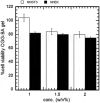pH responsive cationic guar gum-borate self-healing hydrogels for muco-adhesion
- PMID: 36896456
- PMCID: PMC9990695
- DOI: 10.1080/14686996.2023.2175586
pH responsive cationic guar gum-borate self-healing hydrogels for muco-adhesion
Abstract
We developed a new muco-adhesive hydrogel composed of cationic guar gum (CGG) and boric acid (BA). The CGG-BA precursor solution of 0.5-2% w/v concentration exhibited fluidity at low pH (3-5), while gelation occurred within 1 min at physiological pH (7-8) conditions. Scanning electron microscopy and Fourier-transform infrared spectroscopy results confirmed the change in physical and chemical behavior, respectively, with change in pH. The pH-responsive self-healing ability was analyzed through microscopy and rheology. CGG-BA hydrogels showed good self-healing property at pH 7.4. The in vitro biocompatibility test of the hydrogel studied using NIH3T3 and NHEK cells showed that it was non-toxic at concentrations of CGG-BA below 2% w/v. Ex vivo mucoadhesive tests confirmed the hydrogel's potential for use as a muco-adhesive. Burst pressure tests were conducted using pig esophageal mucosa and the results showed that at pH 7.4, 1% w/v CGG-BA self-healable hydrogel resisted about 8 ± 2 kPa pressure, comparable to that of Fibrin glue. This was higher than that at solution (pH 5) and brittle gel (pH 10) conditions. To confirm the good adhesive strength of the self-healable hydrogels, lap shear tests conducted, resulted in adhesive strengths measured in the range of 1.0 ± 0.5-2.0 ± 0.6 kPa, which was also comparable to fibrin glue control 1.8 ± 0.6 kPa. Hydrogel weight measurements showed that 40-80% gel lasted under physiological conditions for 10 h. The results suggest that CGG-BA hydrogel has potential as a pH responsive mucosal protectant biomaterial.
Keywords: Self-healing; hydrogels; muco-adhesion.
© 2023 The Author(s). Published by National Institute for Materials Science in partnership with Taylor & Francis Group.
Conflict of interest statement
No potential conflict of interest was reported by the author(s).
Figures










Similar articles
-
Exploring Cationic Guar Gum: Innovative Hydrogels and Films for Enhanced Wound Healing.Pharmaceutics. 2024 Sep 22;16(9):1233. doi: 10.3390/pharmaceutics16091233. Pharmaceutics. 2024. PMID: 39339269 Free PMC article.
-
Facile Access to Guar Gum Based Supramolecular Hydrogels with Rapid Self-Healing Ability and Multistimuli Responsive Gel-Sol Transitions.J Agric Food Chem. 2019 Jan 16;67(2):746-752. doi: 10.1021/acs.jafc.8b05130. Epub 2019 Jan 3. J Agric Food Chem. 2019. PMID: 30571099
-
l-Alanine induced thermally stable self-healing guar gum hydrogel as potential drug vehicle for sustained release of hydrophilic drug.Mater Sci Eng C Mater Biol Appl. 2019 Jun;99:1384-1391. doi: 10.1016/j.msec.2019.02.074. Epub 2019 Feb 21. Mater Sci Eng C Mater Biol Appl. 2019. PMID: 30889672
-
pH-responsive self-healing injectable hydrogel based on N-carboxyethyl chitosan for hepatocellular carcinoma therapy.Acta Biomater. 2017 Aug;58:168-180. doi: 10.1016/j.actbio.2017.06.001. Epub 2017 Jun 2. Acta Biomater. 2017. PMID: 28583902
-
Injectable and Self-Healing Nanocomposite Hydrogels with Ultrasensitive pH-Responsiveness and Tunable Mechanical Properties: Implications for Controlled Drug Delivery.Biomacromolecules. 2020 Jun 8;21(6):2409-2420. doi: 10.1021/acs.biomac.0c00347. Epub 2020 Apr 29. Biomacromolecules. 2020. PMID: 32310635
Cited by
-
Self-healing hydrogels for bone defect repair.RSC Adv. 2023 Jun 5;13(25):16773-16788. doi: 10.1039/d3ra01700a. eCollection 2023 Jun 5. RSC Adv. 2023. PMID: 37283866 Free PMC article. Review.
-
Exploring Cationic Guar Gum: Innovative Hydrogels and Films for Enhanced Wound Healing.Pharmaceutics. 2024 Sep 22;16(9):1233. doi: 10.3390/pharmaceutics16091233. Pharmaceutics. 2024. PMID: 39339269 Free PMC article.
-
Natural Polymer-Based Hydrogels: From Polymer to Biomedical Applications.Pharmaceutics. 2023 Oct 23;15(10):2514. doi: 10.3390/pharmaceutics15102514. Pharmaceutics. 2023. PMID: 37896274 Free PMC article. Review.
-
Foreword to the focus issue: frontline research on biomaterials-based bioengineering for future therapy.Sci Technol Adv Mater. 2025 Feb 21;26(1):2471206. doi: 10.1080/14686996.2025.2471206. eCollection 2025. Sci Technol Adv Mater. 2025. PMID: 40084220 Free PMC article. No abstract available.
References
-
- Khutoryanskiy VV. Advances in mucoadhesion and mucoadhesive polymers. Macromol biosci. 2011;11(6):748–14. - PubMed
-
- Peppas NA, Sahlin JJ.. Hydrogels as mucoadhesive and bioadhesive materials: a review. Biomaterials. 1996;17(16):1553–1561. - PubMed
-
- Iyer BVS. Effect of functional anisotropy on the local dynamics of polymer grafted nanoparticles. Soft Matter. 2022;18(33):6209–6221. - PubMed
-
- Sreedevi AM, Iyer BVS. Computational study of pair interactions between functionalized polymer grafted nanoparticles. Ind Eng Chem Res. 2019;58:7478–7488.
-
- Chatterjee B, Amalina N, Sengupta P, et al. Mucoadhesive polymers and their mode of action: a recent update. J Appl Pharm Sci. 2017;7(5):195–203.
LinkOut - more resources
Full Text Sources
Other Literature Sources
Research Materials
